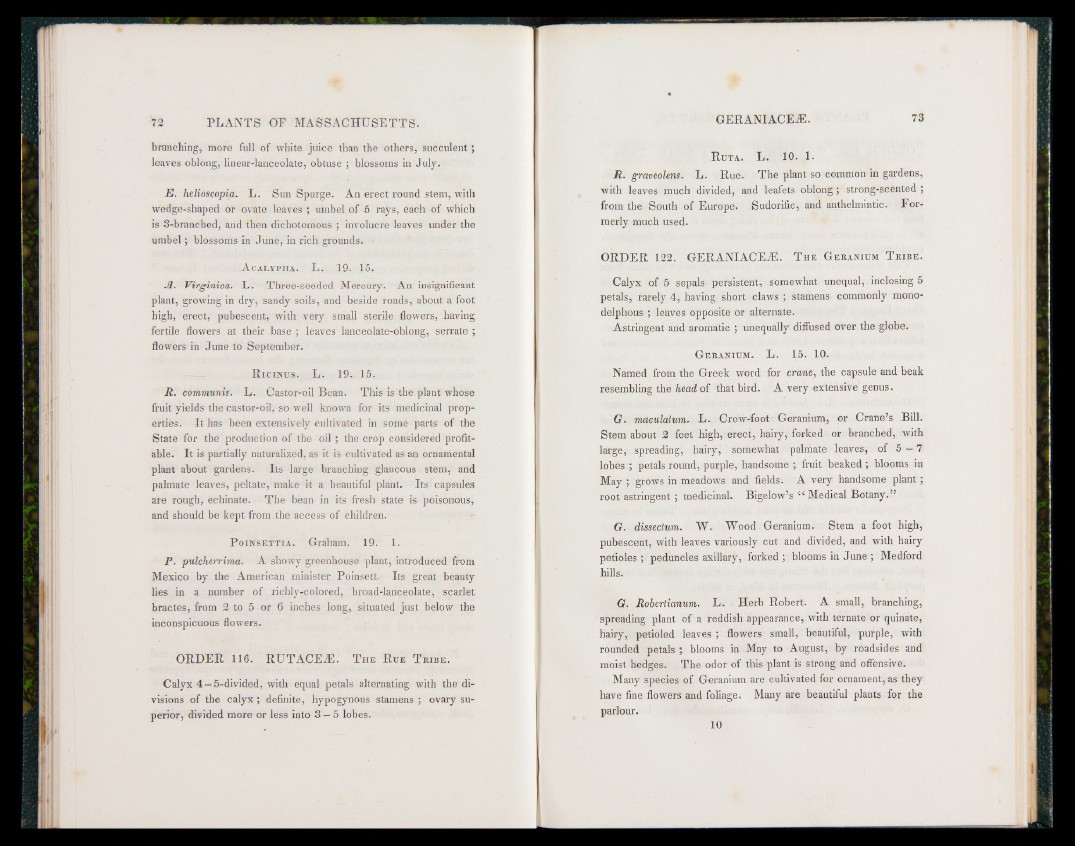
branching, more full of white juice than the others, succulent ;
leaves oblong, linear-lanceolate, obtuse ; blossoms in July.
jE. helioscopia. L. Sun Spurge. An erect round stem, with
wedge-shaped or ovate leaves ; umbel of 5 rays, each of which
is 3-branched, and then dichotomous ; involucre leaves under the
umbel; blossoms in June, in rich grounds. !
A caltpha. L. 19. 15.
«/2. Virginica. L. Three-seeded Mdrcury. An insignificant
plant, growing in dry, sandy soils, and beside roads, about a foot
high, erect, pubescent, with very small sterile flowers, having
fertile flowers at their base ; leaves lanceolate-oblong, serrate ;
flowers in June to September.
R ic inus . L. 19. 15.
R. communis. L. Castor-oil Bean. This is the plant whose
fruit yields the castor-oil, so well known for its medicinal properties.
It has been extensively cultivated in some parts of the
State for the production of the oil ; the crop considered profitable.
It is partially naturalized, as it is cultivated as an ornamental
plant about gardens. Its large branching glaucous stem, and
palmate leaves, peltate, make it a beautiful plant. Its capsules
are rough, echinate. The bean in its fresh state is poisonous,
and should be kept from the access of children.
P oinse tt ia. Graham. 19. 1.
P. pulcherrima. A showy greenhouse' plant, introduced from
Mexico by tbe American minister Poinsett. Its great beauty
lies in a number of richly-colored, broad-lanceolate, scarlet
bractes, from 2 to 5 or 6 inches long, situated just below the
inconspicuous flowers.
ORDER 116. RUTA CEiE. T he R ue T r ib e .
Calyx 4-5-divided, with equal petals alternating with the divisions
of the calyx; definite, hypogynous stamens ; ovary superior,
divided more or less into 3 — 5 lobes.
R uta. L. 10. 1.
R. graveolens. L. Rue. The plant so common in gardens,
with leaves much divided, and leafets oblong ; strong-scented ;
from the South of Europe. Sudorific, and anthelmintic. Formerly
much used.
ORDER 122. GERANIACEiE. T he G eranium T r ib e .
Calyx of 5 sepals persistent, somewhat unequal, inclosing 5
petals, rarely 4, having short claws ; stamens commonly mono-
delphous ; leaves opposite or alternate.
Astringent and aromatic ; unequally diffused over the globe.
G eranium. L. 15. 10.
Named from the Greek word for crane, the capsule and beak
resembling the head of that bird. A very extensive genus.
G. maculatum. L. Crow-foot' Geranium, or Crane’s Bill.
Stem about 2 feet high, erect, hairy, forked or branched, with
large, spreading, hairy, somewhat palmate leaves, of 5 — 7
lobes ; petals round, purple, handsome ; fruit beaked ; blooms in
May ; grows in meadows and fields. A very handsome plant;
root astringent; medicinal. Bigelow’s “ Medical Botany.”
G. dissectum. W. Wood Geranium. Stem a foot high,
pubescent, with leaves variously cut and divided, and with hairy
petioles ; peduncles axillary, forked ; blooms in June ; Medford
hills.
G. Robertianum. L. • Herb Robert. A small, branching,
spreading plant of a reddish appearance, with ternate or quinate,
hairy, petioled leaves ; flowers small, beautiful, purple, with
rounded petals ; blooms in May to August, by roadsides and
moist hedges. The odor of this plant is strong and offensive.
Many species of Geranium are cultivated for ornament, as they
have fine flowers and foliage. Many are beautiful plants for the
parlour.